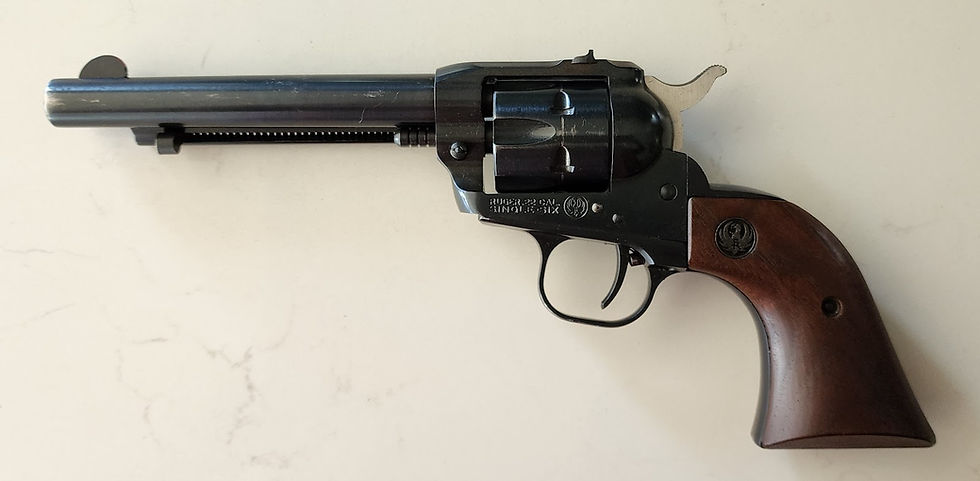The Winchester Model 36
- Uncle Kenny

- Sep 12
- 3 min read
A Mule Plow, a 9mm Rimfire, and a Lifetime of Memories
Cousin Denny could talk to mules in a way that made them behave. Back in the Missouri fields of my youth, he spent long spring days behind a plow, guiding two stubborn mules until the soil turned dark and ready for planting. Strapped to the side of that plow in a worn scabbard rode his Winchester Model 36. Every so often a groundhog or rabbit would break cover and that little single shot cracked like lightning. The mules barely twitched.

When I was a boy, I earned ten cents a day working alongside Denny. My job was to scoop mule manure and pry rocks out of the fresh furrows. The smell of damp earth and mule sweat lingers in my memory even now. I would glance at that Winchester on the plow and dream about the day I might carry a gun of my own. That little 9mm rimfire, sometimes called a Flobert, seemed like pure magic.
One late afternoon a mule kicked and nearly killed Denny. We were sure he would not make it. He healed slow, but the Winchester was still hanging in the barn when he came home, oiled and waiting for the next season. That gun was a quiet witness to both the danger and the stubborn beauty of working Missouri ground.
An Odd Chapter in Winchester History
The Winchester Model 36 is one of the most unusual shotguns to wear the Winchester name. Produced from 1920 through 1927, it was a single shot smoothbore chambered for the 9 mm rimfire shotshell, better known in Europe as the 9 mm Flobert. The name comes from Louis Nicolas Flobert, the French inventor who in 1845 created the first true metallic cartridge by marrying a percussion cap with a small bullet. His design set the stage for every modern cartridge that followed.

The 9 mm Flobert round is closer to a garden gun cartridge than a traditional rifle or shotgun round. It carries a very light powder charge and is designed to throw a pinch of fine shot at short range. Think of it as a tiny shotgun shell meant for dispatching rats in a barn or keeping sparrows out of a fruit tree. In the early 1900s European gardeners relied on it, and Winchester recognized that American farmers had the same need. The Model 36 was their answer.
Winchester kept the gun simple. It used a falling-block action with a straight-grained walnut stock and a short barrel that made it easy to handle from a horse or while working a plow. Its effective range was about the distance across a small garden, which was all anyone needed for small vermin. Even when it was new the 9 mm Flobert round was a specialty item. Ammunition makers offered both shot and round ball loads, but it never became a mainstream American cartridge. That scarcity is part of what makes the Model 36 such an intriguing piece for collectors today.
A Familiar Old Friend in Webster Groves
This job still surprises me after all this time. Not long ago we were asked to complete an insurance appraisal in Webster Groves. The collection included several fine shotguns and there among them sat a Winchester Model 36. The moment I saw it I was back in those fields, a kid with a ten cent wage and a shovel in my hands. The smell of dirt and the sound of those mules came rushing back as if no time had passed.

Reflections from and Old Man
Now that I am getting up in years, buying and appraising firearms gives me a chance to touch the pieces of my own past. When I saw that Model 36 I could practically see Denny’s grin and the way he tipped his hat after surviving that mule’s kick. These guns are more than wood and steel. They carry the stories of the people who worked the land and faced the dangers of nature and mean ass Mules.
Final Word from Uncle Kenny
The Winchester Model 36 may be an oddity in the Winchester lineup, but it holds a special place in my heart. It represents a time when a firearm was both tool and companion, a quiet partner in a life built on soil, sweat, and family. Seeing one again in that Webster Groves appraisal reminded me that this work lets me reconnect with the guns of my youth and the memories they still carry.






Good job uncle Kenny. I heard you have a stubborn streak now I can understand since you worked with all those mules. 😊